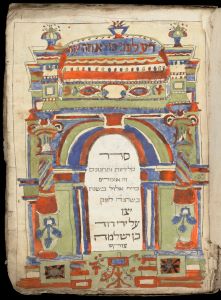Selichot are penitential prayers and hymns recited before and during the Ten Days of Repentance that extend from Rosh Hashanah to Yom Kippur. Its central components are the confession of sins (vidui) and the recitation of God's thirteen attributes (Exodus 34:6–7).
Notable Sources
All Sources
A
The Thirteen Attributes of God TANAKH
The Thirteen Attributes of God
TANAKH
The refrain throughout the selichot (penitential prayers) is the recitation of God’s thirteen attributes. In a dramatic moment representing God’s forgiveness of the children of Israel in the desert after the making of the golden calf, God shares with Moses this formula for God’s forgiveness.
When Selichot are Recited HALAKHAH
When Selichot are Recited
HALAKHAH
There are different traditions as to the calendar day on which one begins to recite selichot (penitential prayers). Joseph Karo presents the Sephardi practice in his sixteenth-century Shulchan Arukh, and Moses Isserles records the Ashkenazi tradition in his commentary.
Master of Forgiveness LITURGY
Master of Forgiveness
LITURGY
Selichot prayers are poetic compositions meant to help us to focus on God’s judgment and mercy. This poem, from the selichot of the Sephardi-Mizrachi liturgical tradition, is an acrostic of the Hebrew alphabet, proclaiming God’s mercy and character traits.
God Teaches Moses to Pray TALMUD
God Teaches Moses to Pray
TALMUD
God taught Moses the formula for divine forgiveness, for reciting selichot, after the children of Israel built the golden calf in the desert at Sinai. The Talmud begins to interpret this formula, the attributes of God, and its role in Jewish prayer.
The Power of SelichotCHASIDUT
The Power of Selichot
CHASIDUT
Prayer, including selichot, can be powerful, both in its impact on the person praying, the community, and on God. The Shivchei HaBesht — a collection of legends about the eighteenth-century founder of the Chasidic movement, known as the Besht — records a Chasidic tale that recounts a prayer leader stopping short out of fear that his prayers would be too powerful.
The Timing of SelichotCOMMENTARY
The Timing of Selichot
COMMENTARY
Selichot are typically recited late at night. Rabbi Israel Meir Kagan, author of the late nineteenth-century Mishnah Berurah, explains why late nights during the month of Elul are the ideal time to ask God’s forgiveness.
God, Merciful and CompassionateCOMMENTARY
God, Merciful and Compassionate
COMMENTARY
Amidst the selichot (penitential prayers), one proclaims God’s thirteen attributes, the first two of which are “merciful and compassionate.” The eighteenth-century Vilna Gaon, author of the Torah commentary, Aderet Eliyahu, explains what was at stake when God taught Moses this prayer formula.
Four Times TenKABBALAH
Four Times Ten
KABBALAH
Among Sephardi Jews, selichot (penitential prayers) are recited for the forty days from the beginning of the month of Elul until Yom Kippur. The sixteenth-century kabbalist, Rabbi Eliyahu de Vidas explains why this is so based on hints and spellings in the biblical text.
You Are Standing Here Today CHASIDUT
You Are Standing Here Today
CHASIDUT
The Torah portion Nitzavim, “You are standing” is read on the Shabbat before Rosh Hashanah. The chasidic eighteenth-century work Avodat Yisrael brings together many of the themes of the season of repentance, including selichot (the penitential prayers), in order to explain why this Torah portion is read the Shabbat before Rosh Hashanah.
When a Brit (Circumcision Ceremony) Falls on a Fast Day? RESPONSA
When a Brit (Circumcision Ceremony) Falls on a Fast Day?
RESPONSA
Selichot (penitential prayers) are also recited on communal fast days, not just before Rosh Hashanah. The noted 11th-century French biblical commentator and legal decisor Rabbi Solomon ben Isaac, best known as Rashi, responds to the question of whether selichot should still be recited when a circumcision—a celebratory event—was also taking place.
The RefrainLITURGY
The Refrain
LITURGY
Selichot (penitential prayers) repeat the verses from the book of Exodus that narrate God passing before Moses and proclaiming the thirteen attributes of God. This poetic prayer emphasizes that God is forgiving, merciful, and good.



